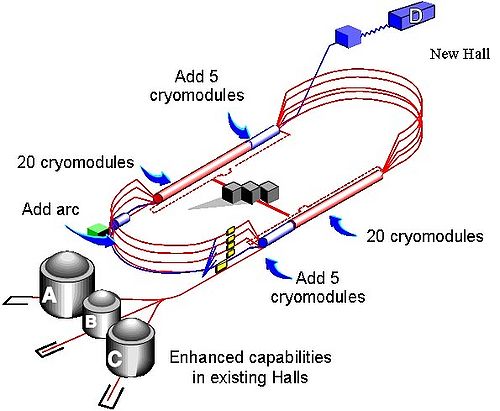Difference between revisions of "Tamar Thesis CEBAF"
| Line 14: | Line 14: | ||
| Electron beam energy E (GeV) || <math>0.8 \leq E \leq 6.0</math> | | Electron beam energy E (GeV) || <math>0.8 \leq E \leq 6.0</math> | ||
|- | |- | ||
| − | | Electron beam current (<math>\mu Amp</math>) || | + | | Max Electron beam current in one Hall(<math>\mu Amp</math>) || 175 |
|- | |- | ||
| Energy spread (<math>\Delta E/E</math>) || <math>10^{-4}</math> | | Energy spread (<math>\Delta E/E</math>) || <math>10^{-4}</math> | ||
Revision as of 15:37, 28 December 2010
The Continuous Electron Beam Accelerator Facility (CEBAF) at Thomas Jefferson National Lab contains two 0.5 GeV linacs connected by five sets of recirculated arcs and a 45 MeV polarized electron beam injector with a transverse emittence of less than mm-mrad and a longitudinal emittence of less than keV-degrees. In oder to minimize the total accelerator circumference, the accelerator structure was arranged in two separate linac segments. Each linac segment contains 25 crymodules, which house 8 superconducting radio-frequency cavities. Each crymodule is seperated by a vacuum port, beam diagnostics, and quadrupole and dipole magnets. Quadrupole and dipole magnets are used focus and steer the beam. Electrons are accelerated by microwave fields generated by klystrons and propagated through wave guides to radio-frequency accelerating cavities.<ref name="Grunder1987"> Grunder, H.A., et al. (1987). The Continuous Electron Beam Accelerator Facility. CEBAF-PR-87-017.</ref>
Figure 1. CEBAF Schematics.
A Klystron is a microwave amplifier in which a low energy microwave signal breaks a continuous electron beam into so called bunches. After that the beam passes through the resonant waveguide, where it induces a high energy microwave signal. The transmitted microwave radiation is transported to a superconducting radio-frequency(RF) cavity where it accelerates electrons.The electromotive force(EMF) induced in the RF cavity is roughly parallel to the beam axis and decaying to zero radially at the walls. The EMF induces charge on the interior surfaces of the cavities such that the electrons moving through the cavity see a positive charge in front of them and accelerate towards that charge. After the beam reaches the desired energy the three beams are separated at the switch yard and sent to the experimental halls labeled A, B and C. The separation between the bunches of 2.04 ns.<ref name="Diamond1987"> Diamond, W. (1987). The Injector for the CEBAF cw Superconducting Linac. CEBAF-PR-87-011.</ref>
The CEBAF accelerator parameters <ref name="Grunder1987"> Grunder, H.A., et al. (1987). The Continuous Electron Beam Accelerator Facility. CEBAF-PR-87-017.</ref>
| Quantity | Value |
|---|---|
| Electron beam energy E (GeV) | |
| Max Electron beam current in one Hall() | 175 |
| Energy spread () | |
| Electron beam polarization | 40-80% |
| Simultaneous beams | 3 |
| Number of linac segments | 2 |
| Number of passes | 4 |
| Maximum energy gain per pass (GeV) | 1.5 |
The polarized electron beams have been generated at JLab since using a polarized gun. The polarized electrons are produced by creating bandgap photoemission from a strained GaAs cathode. When the cathode is exposed by a circularly polarized laser light, the polarized electrons move from the valence region to the conduction band. In order to free the electrons from the conduction band, the surface of the GaAs cathode is coated with a single layer of cesium and fluorine. As a result, electrons in the conduction band are bound to the surface of the material by only 4 eV. The sign of the electron polarization is flipped with a frequency of 1 Hz by reversing the laser polarization. The electron beam polarization for each hall can be changed with a Wien Filter, it can rotate electron spin without changing its momentum. <ref name="Engwall1992"> Engwall, D.A., et al. (1992). A spin manipulator for electron accelerators. CEBAF-PR-92-019</ref>
The beam polarization is monitored using a 5 MeV Mott polarimeter and a Moller polarimeter in Hall B. The average electron beam polarization achieved during the eg1b experiment was around 70%.
insert average value and uncertainty
The integrated electron beam current is measured using a Farady cup. The Faraday cup i slcoated downstream of the CLAS target and contains several layers of lead and scintillator in order to create a large amount of detected secondary particles from the primary electron beam. The position of the beam is monitored with a three beam position monitors. The profile of the beam is monitored with a harp scan, a device with thin iron
iron or Tungsten?
wires moved around the beam.
Notes
<references/>
http://www.jlab.org/div_dept/admin/publications/papers/92/PR92-019.pdf
